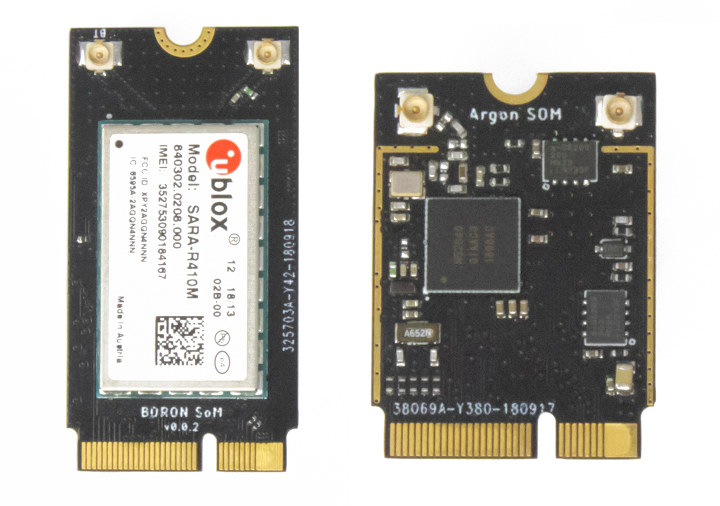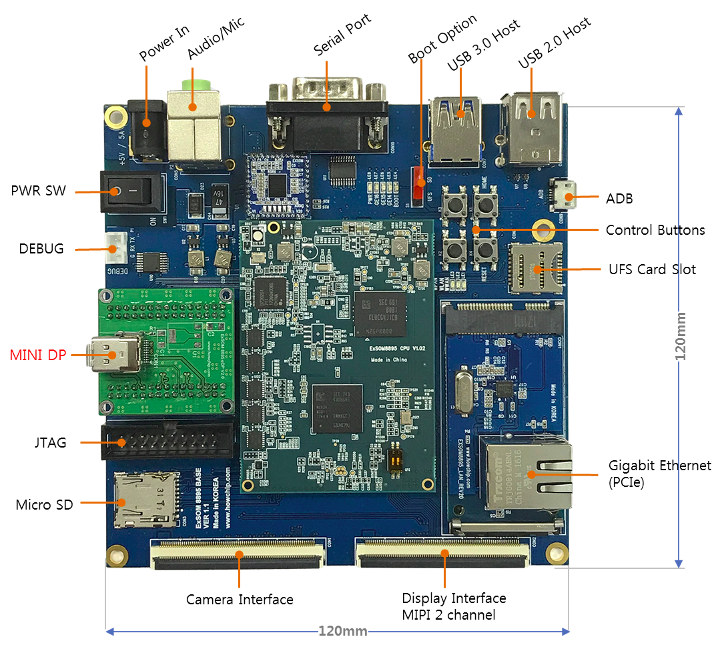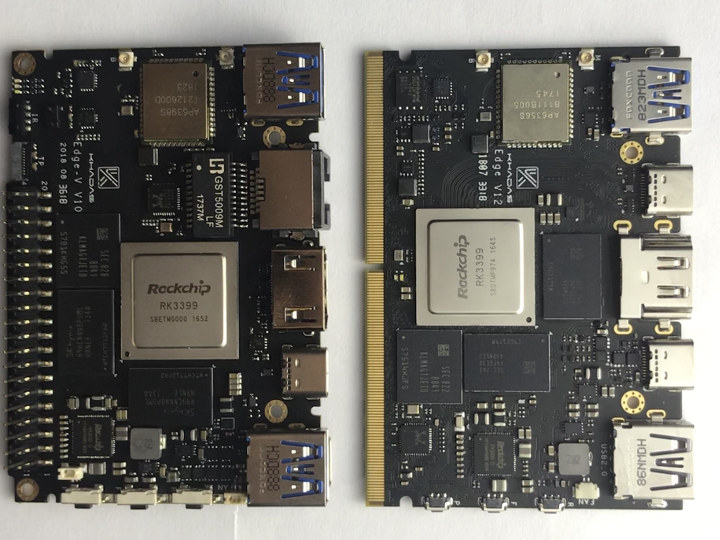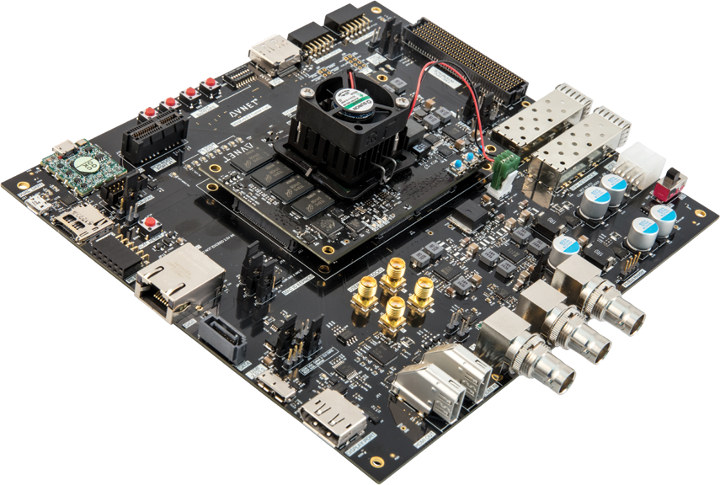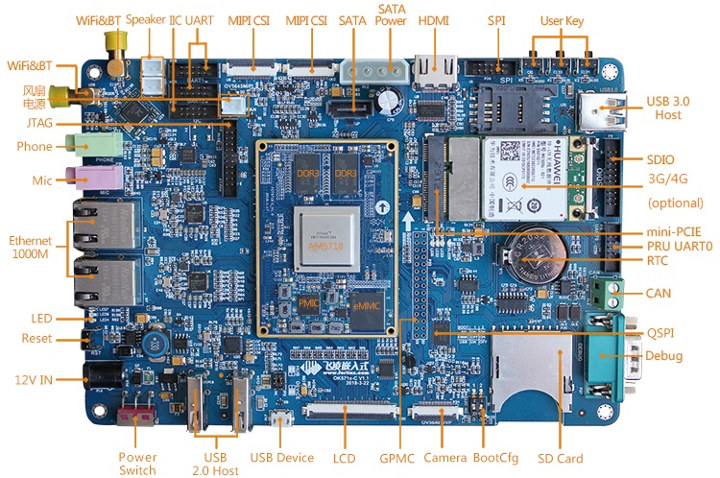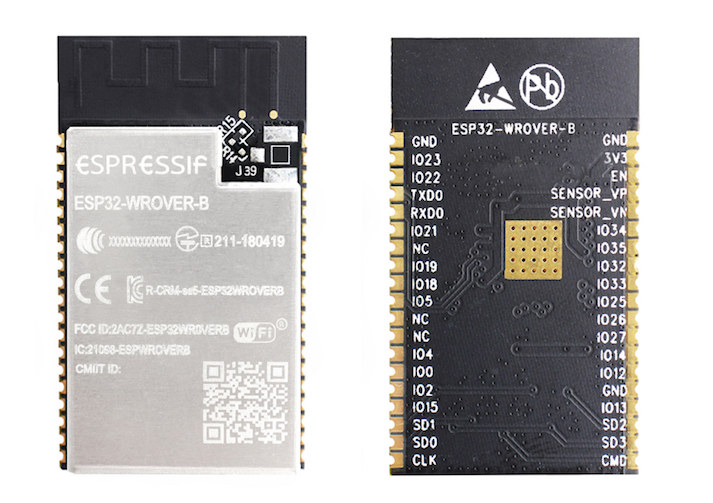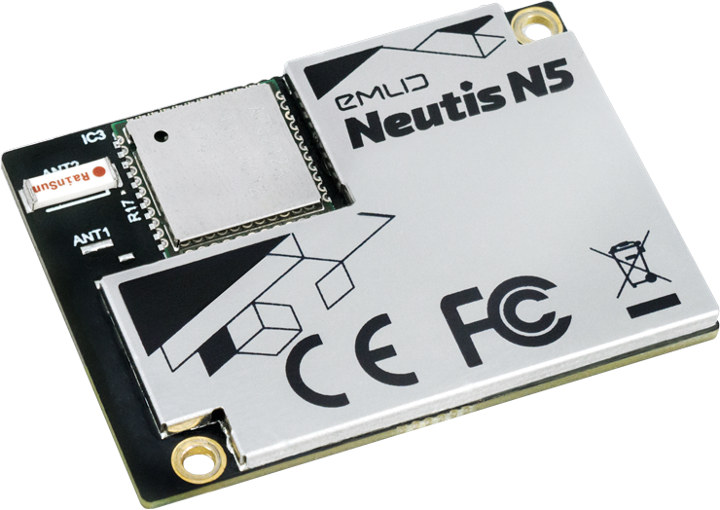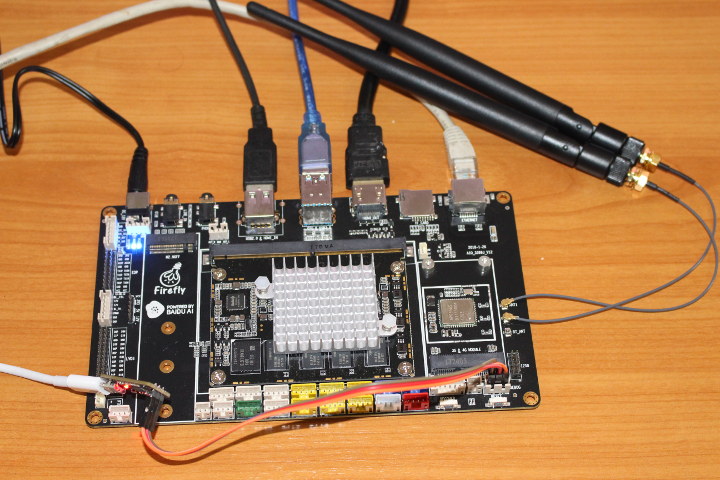Earlier this year, Particle unveiled three IoT development boards based on nRF52840 Bluetooth 5/802.15.4 WiSoC and supporting Particle Mesh, which interestingly is not based on Bluetooth Mesh or even Bluetooth, and instead relies on Thread specification/OpenThread implementation, and the 802.15.4 radio of the chip with Bluetooth only used for the initial setup stage. Particle announced the shipping date (October 2018 or… this month) for their Mesh boards pre-ordered in February, as well as three new products in a recent blog post. One of the products is a family of system-on-modules compatible with Particle Mesh, while the other two are related IoT developer tools. Particle Mesh SOMs The Particle Mesh SOMs will have similar names and features as corresponding Particle mesh developers kits such as Boron (NB-IoT / eMTC + BLE + Mesh) and Argon (ESP32 WiFi, BLE + Mesh), but with an edge connector and designed as enterprise-grade, production-scale version […]
Howchip ExSOM-8895 Exynos 8895 Board is Designed for Android Development
Howchip has just launched a new Samsung based Android development kit -ExSOM-8895 DVK – powered by an Exynos 8895 system-on-module with 4GB DDR4, and UFS 2.1 storage. as well as featuring a carrier board exposing other interfaces such as mini DP, MIPI display and camera interfaces, Gigabit Ethernet, a UFS card reader, and so on. Having a Samsung Exynos 8895 board means we get a fairly powerful development platform, as the processor is found in Samsung Galaxy S8 smartphone released last year. ExSOM-8895 DVK specifications: SOC – Samsung Exynos 8895 octa-core processor with four custom ARMv8 “Mongoose M2+” cores, four Cortex-A53 cores (max freq: 2.1GHz), and an Arm Mali-G71 GPU System Memory – 4GB LPDDR4x 1866MHz (POP) Storage – UFS2.1 device (default), micro SD card (SD 3.0) slot, and UFS2.1 card slot, Video Output / Display I/F Mini Display Port 1.2 output 4-lane x 2-ch MIPI DSI connector for WQUXGA […]
Khadas is Working on more RK3399 / RK3399Pro Boards, Projector Development Kit, AR Kit
Shenzhen Wesion had already unveiled their Khadas Edge board that works both as a system-on-module and a standalone SBC thanks to an MXM3 connector on one side, and traditional HDMI and USB ports on the other. The Rockchip RK3399 board will be launched on Indiegogo a little later. But the company is working on a few more boards and development kits all based on Rockchip RK3399 or the upcoming RK3399Pro processor with neural processing unit (NPU) for AI workloads acceleration. First we have Khadas Edge-V, very similar to Khadas Edge but with a 40-pin IO header replacing the MXM3 connector, and following Khadas VIM form factor and ports, so for example we get an Ethernet port as well as an extra USB 3.0 port instead of USB 2.0 on Edge. As mentioned in Khadas Edge announcement, the company is also working on Khadas Captain carrier board with MXM3 socket. So we […]
UltraZed-EV Starter Kit Support Simultaneous 4K Encoding and Decoding with Xilinx Zynq UltraScale+ EV MPSoC
Xilinx unveiled Zynq UltraScale+ MPSoC‘s combining Arm Cortex A53/R5 cores with FPGA fabric back in 2015. and we started to see development boards and products based on the solution starting in 2017 with offerings such as AXIOM Board, TRENZ TE0808 SoM, or more recently 96Boards compliant Ultra96 development board. All last three boards have one thing in common: they all use an Zynq UltraScale+ GC MPSoC that adds a Mali-400MP2 GPU to CG MPSoC family. But there’s also a third EV family which standards for “Embedded Vision”, and adds support for 4K H.264 / H.265 hardware video codec capable of simultaneous encode and decode. The platform targets multimedia, automotive ADAS, surveillance, and other embedded vision applications. So far, I don’t think I had seen any boards based on Ultrascale+ EV MPSoC, but AVNet – following up on their UltraZed-EG starter kit – has now launched an UltraZed-EV starter kit powered […]
Forlinx OK5718-C Development Board is Powered by TI AM5718 Cortex-A15/M4 processor
Forlinx Embedded Technology (Forlinx) has just launched a new development board for indsutrial applications with audio and video processing requirements. OK5718-C development board features Texas Instruments AM5718 Sitara SoC with a single Arm Cortex-A15 core, two real-time Cortex-M4 cores, a dual PRU, and a TI C66x DSP core. OK5718-C development board consists of a carrier board and FET5718-C SoM with the following specifications: FET5718-C System-on-Module SoC – TI AM5718 Sitara Arm Cortex-A15 processor @ up to 1.5GHz, C66x DSP @ 750MHz, dual-core Arm Cortex-M4 @ 213MHz, dual core PRU @ 200MHz, PowerVR SGX544 3D GPU, Vivante GC320 2D GPU, IVA-HD video accelerator subsystem (H.264, MPEG4, MPEG2, VC1) System Memory – 1GB DDR3L Storage – 8GB eMMC flash Board-to-board connectors for interface with baseboard – 320–pin exposing USB 3.0, PCIe 3.0, HDMI 1.4a, LCD RGB, 10x UART, 1x QSPI, 2x CAN, 2x Gigabit Ethernet, etc… PMU – TI TPS659162RGZR Supply Voltage – […]
Espressif Introduces ESP32-WROVER-B Module with 8MB RAM
ESP32 processor can support PSRAM, and so far I had seen boards or modules with up to 4MB RAM, but if you need more memory, Espressif Systems has now launched ESP32-WROVER-B module with 8MB SPI PSRAM. ESP32-WROVER-B module specifications: WiSoC – Espressif ESP32-D0WD with dual core processor up to 240 Mhz; 5x5mm package Connectivity 2.4GHz WiFi 802.11 b/g/n up to 150 Mbps Bluetooth 4.2 LE Two antenna designs: PCB antenna or IPEX connector External Memory – 8MB SPI Pseudo Static RAM (PSRAM) Storage – 4MB external SPI flash I/Os – Capacitive touch, SD card interface, Ethernet, SPI, UART, I2S, I2C, GPIOs, VP/VN, etc… Power Supply – 2.7 to 3.6V Dimensions – 31.4 x 18.0 x 3.3 mm Certifications – FCC/CE-RED/IC/TELEC/KCC/SRRC/NCC ESP32-WROVER-B should be software compatible with other ESP32 modules. It works ESP-IDF framework based on FreeRTOS with LwIP ( light-weight Internet Protocol). TLS 1.2 hardware acceleration is built-in, and secure OTA […]
Neutis N5 Allwinner H5 CPU Module and Development Kit are now up for pre-order
Emlid Neutis N5 system-on-module (SoM) powered by Allwinner H5 processor was unveiled right before Embedded World 2018 in February with an expected launch date scheduled for April. There have been some delays but the Allwinner H5 CPU module and corresponding development kit are now up for pre-order with delivery slate for the end of August. Neutis N5 SoM Neutis N5 specifications: SoC – Allwinner H5 quad core Arm Cortex-A53 processor @ up to 1.3 GHz with Arm Mali-450MP4 GPU System Memory – 512 MB DDR3 RAM Storage – 8 GB eMMC flash Connectivity – Wi-Fi 802.11 b/g/n. Bluetooth 4.0 dual-mode BLE with on-board antenna and u.FL connector for optional external antenna HW Security – Tamper-resistant dedicated crypto chip (secure element) for storing cryptographic keys, unique ID, random number generation and more 2x DF40 80-pin board to board X1 and X2 connectors with 38x GPIOs 4x UART, 3x I2C, 2x SPI, […]
AIO-3399J Development Board Review with Ubuntu 16.04
Regular readers will know that Firefly team sent me several of their Rockchip boards for evaluation, and I started with a review of ROC-RK3328-CC development board powered by Rockchip RK3328 processor. This time, I went with the high-end AIO-3399J board comprised of a features-packed baseboard and a Rockchip RK3399 system-on-module. Just like with the previous review, I’ve decided to focus on Linux support, in this case Xunbuntu 16.04, and I’ll do an Android review on the company releases Android 8.1 for Firefly-RK3399 board. First Boot with AIO-3399J Board Before booting the board, I inserted the heatsink, and connected the provided WiFi antennas. I also connected some devices and cables, including a mouse, the male to male USB cable to the top USB 3.0 (OTG) port for firmware update, a HDMI cable to my TV, and Ethernet cable, as well as the serial debug board. The final step was to connect […]


